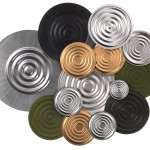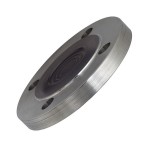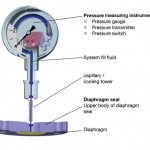Diaphragm seals are mainly used if, for example, very hot or highly corrosive processes prohibit the direct connection of pressure measuring instruments to the process medium. Wika diaphragm seals are available in various highly resistant materials and diverse designs to assure compatibility with a wide range of pressure instruments.
Jennifer Breunig
Using flange-type diaphragm seals, pres-sure measuring instruments can be adapted to the most severe conditions in the chemical and petrochemical industries. More than 35 years ago, Wika introduced an innovative flange-type diaphragm seal – the 990.27 model – into its portfolio. In the meantime, it protects thousands of measuring instruments all over the world against aggressive, corrosive, highly viscous, impure or hot media.
A diaphragm seal consists of a pres-sure measuring instrument with a fitted diaphragm and a system fill fluid that transfers the process pressure from the seal to the measuring instrument hydraulically. The process pressure influences the diaphragm, which uses the fill fluid to transfer pressure to the measuring element (bourdon tube, silicone chip) of the pres-sure measuring instrument (for example a pressure gauge, transmitter or pressure switch). The measuring element can be connected to the diaphragm seal via a cooling element, a capillary or directly.
Diaphragm materials
As a rule, corrosion-resistant stainless steel 316L (1.4404/1.4435) is used to manufacture the diaphragm. If this material is not sufficiently resistant to corrosive process media, all wetted parts of the diaphragm seal can be covered or coated with plastic, e.g. PTFE or ECTFE. A further option is to apply a wikaramic ceramic coating as lasting protection against abrasion.
Diaphragms for especially critical applications are made of exotic materials, such as tantalum or various Hastelloy types. Complications can arise if, depending on the medium, this kind of diaphragm is used at high temperatures. In the past, compromises regarding the diaphragm seal version have been inevitable in such cases, because the special material must cover the whole sealing face of the seal.
A diaphragm made of tantalum, for instance, and welded to a 316L base plate is not reliable. Particularly in vacuum applications, folds can often occur on the sealing face, leading to diaphragm rupture. Furthermore, welding of the diaphragm to the base plate by means of a laser beam can result in the formation of a hybrid structure consisting of, say, 316L and the special material that is susceptible to corrosion.
Another method of joining special materials to the flange is gluing. The special gluing process for specific diaphragms is only applicable up to a maximum medium temperature of +150 °C, although there are also problems with this procedure, for example adhesive degassing during the evacuating process or the diffusion of gases into the system fill fluid.
One possible alternative would be to produce diaphragm seals from solid special materials, which would enable the diaphragm to be welded to the flange without difficulty. However, this solution is very cost-intensive.
Metallic bonding
The metallic bonding process patented by Wika allows exotic materials, such as Hastelloy, Monel or tantalum, to be joined to the stainless steel flange. The special material diaphragm is bonded over the whole of the sealing face. This metallically bonded connection is free of pores and the helium tightness is higher than 10–9 mbar l/s. Moreover, this process places the diaphragm slightly deeper in the flange, so that the risk of dia-phragm damage during transportation or installation is reduced. This type of diaphragm seal arrangement can be used without any problems at high, continuous temperatures of up to +400 °C. The only limitation is imposed by the maximum operating temperature of the system fill fluid or special material.
Users can choose from more than twenty different special materials for the diaphragm seal, of which Hastelloy C4, Hastelloy C276, tantalum and Monel 400 are the most common for chemical and petrochemical applications.
Hastelloy C4 and C276 alloys are primarily used for chemical process technology and equipment. They demonstrate good or very good corrosion resistance – for example to contaminated mineral acids at high temperatures, solvents, chlorine or media containing chlorine, formic and acetic acid or brine and salt solutions – in a wide range of operating conditions. Tantalum boasts exceptionally good resistance, comparable to that of glass or platinum. The metal is not affected by the majority of organic or inorganic materials at ambient temperature. This excellent corrosion-proofness is attributable to the fact that tantalum forms a strongly adhesive surface layer of tantalum pentoxide. Monel alloy 400 is resistant to organic and inorganic acids, caustic alkali solutions and salts in the most diverse conditions and is more suitable for reduction than for oxidation.
Ceramic coating
Wika developed the ceramic wikaramic coating for its flush and threaded metal diaphragm seals to simplify for pressure measurements of abrasive media. This coating offers high abrasion resistance, protecting the sensitive diaphragm and preventing rapid wear. The production of silicone is a typical example of a process application involving abrasive media. The basic materials are finely ground silicon and methyl chloride. The pressure is monitored by blowing silicon sand onto the diaphragm seal membranes.
Hastelloy, a corrosion resistant alloy, is normally used for this purpose. However, like steel, this material can also wear quickly. A Hastelloy diaphragm with an additional wikaramic coating represents a more durable solution that cuts the costs for users. Wika currently produces more than 35,000 flange-type diaphragms annually for chemical and petrochemical plants worldwide. Since the conditions in the process industry are often extremely harsh, specially selected materials and designs afford effective protection for the pressure measuring instruments, leading to reduced downtime, longer maintenance intervals and increased system stability. As measuring conditions can vary considerably, the diaphragm seal assembly has to be optimised for each application.
Hall 10.1, Booth C36
Online-Info www.cpp-net.de/2209457
Share:









